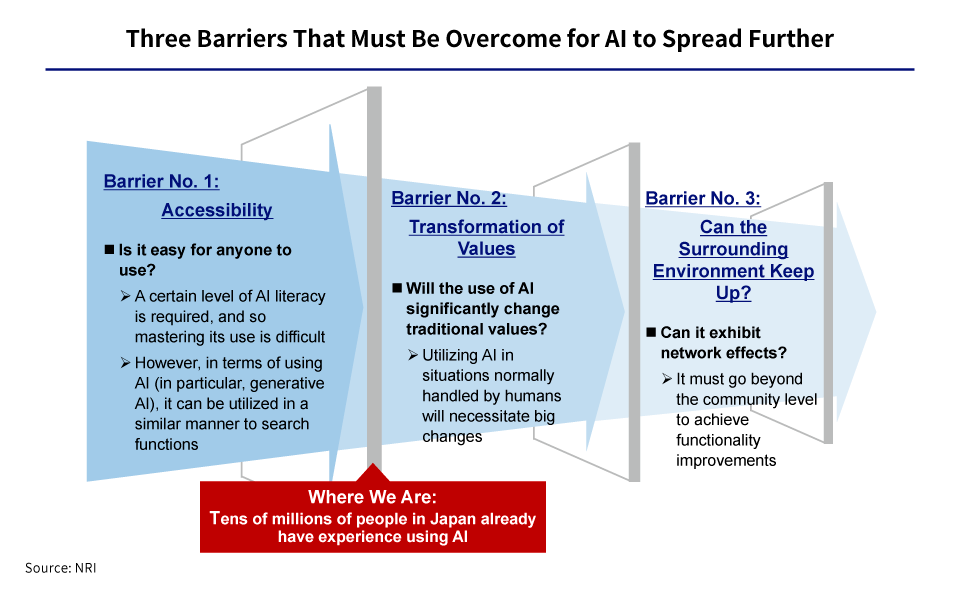
ICT & Content Industry Consulting Department, Hiroki Ito, Rana Katayose
With generative AI spreading rapidly, people in Japan are becoming increasingly exposed to AI-related information. The technology is advancing at an astonishing pace, leading AI to be used not just for performing searches but for generating images and videos as well, and expectations for what AI can do are growing by the day. In the midst of these developments, Nomura Research Institute (NRI) conducted a survey in October 2024 with 2,073 people between the ages of 15 and 79, analyzing their level of AI awareness and their frequency of use, their receptiveness toward the use of AI in different everyday-life situations, their level of trust in AI, and more. We sat down with Hiroki Ito and Rana Katayose of NRI’s ICT & Content Industry Consulting Department who are well versed on this issue, and asked them about the fields in which AI is becoming most prevalent in Japan, as well as future prospects for its use.
The “six abilities” AI has that will expand human intellectual abilities
We are already seeing examples around the world of how these six abilities are being expanded. In the near future, we can likely expect to see these same kinds of examples occur in Japan as well. In particular, with Japan facing a deepening workforce shortage amid population decline, there will need to be discussions about leveraging AI to maintain the quality of services, and AI will have to be utilized in a variety of everyday-life situations.
Everyday-life situations in which AI use is now widespread
When you want to dine out, for example, an AI agent would consider your preferences and plans, the weather that day, and predicted congestion based on customer flow data and then decide on a restaurant. When you arrive, an AI “staff” member that knows how many patrons are in your party shows you to the optimal table. When taking your orders, it then checks each person’s preferences regarding ingredients, flavors, cooking methods, and so on, and then comes up with a recipe based on the available ingredients. Even with this one example of dining out, we can envision how AI may be used in any situation from choosing a restaurant to serving food. This concept has already begun to germinate, and through the combination of multiple functions, such AI “staff” could possibly even handle a whole series of tasks.
The use of AI also holds promise when it comes to solving the labor shortage in medical settings.
For example, when a patient comes to the hospital, a hospital check-in notification will get delivered via a facial recognition gate, and his or her completed medical questionnaire is then sent to a physician. During the exam, an AI doctor inquires about the patient’s symptoms while referencing his or her medical history, and then transcribes that information into the patient’s clinical records. When prescribing medicine, the AI will use the patient’s chart and genetic information to predict any potential future illnesses, and then formulate the optimal medicine for that person. We are also already seeing such cases begin to emerge, and although at present these are limited to partial applications of AI, we may expect that eventually, AI will handle the entire process, thereby eliminating the labor shortage in the medical field.
How can we overcome the barriers and psychological hurdles to the spread of AI?
Meanwhile, it is also apparent that the lack of understanding about AI has led to these low levels of acceptance, and thus among those who had never heard of generative AI, more than half responded that they “do not want to use AI at all”. Spreading understanding of AI will likely be the key to addressing this psychological hurdle.
That said, there are also some psychological hurdles that cannot be eliminated merely with a greater understanding of AI, such as concerns over AI’s precision, uncertainties regarding where responsibility lies when there are problems, and people’s appreciation of the value of having a human being help them. For instance, with regard to everyday-life situations involving people’s well-being, livelihoods, or assets (e.g., healthcare/nursing, government, finance), many respondents said that “I don’t want to use AI because it’s hard to know where the responsibility lies when problems occur”, whereas when it comes to everyday-life situations premised on manned services (lodging/dining out/schooling, etc.), most respondents said that “I don’t want to use AI because I think having someone there to help is part of the service”. When it comes to understanding why people are reluctant for AI to be used in a given everyday-life situation, we must first grasp the background behind why their receptiveness to AI is so low.
In our survey, we also inquired about public perceptions of AI. When we checked people’s level of trust regarding the AI agent “AI Great Men”, which has recreated images of great figures from history, 39% of respondents said they could fully or at least partly trust those images. Furthermore, when asked whether they “think AI can be controlled by human beings” or whether they “believe AI has a will”, there were variations in the responses. This suggests that people’s perceptions regarding AI still vary considerably.
What the fields most accessible to AI use have in common, and the barriers that AI must overcome
Given the history of how new technologies spread in the past (mobile phones, etc.), there are three barriers standing in the way of AI’s further widespread use, namely “accessibility”, “transformation of values”, and “getting the surrounding environment to keep up”. It would seem that the first barrier, “accessibility”, has already been overcome.

As for “transformation of values”, in the fields mentioned above where AI is more apt to be utilized, we must pay attention to how AI stands to change everyday-life situations which it had previously been assumed would always be handled by human beings. We may also anticipate that as the use of AI spreads further, we will see a transition from partial optimization to overall optimization. Just as the manufacturing industry has become more specialized, we can expect that there will be similar divisions of labor among different AIs, leading to performance improvements.
Lastly, with AI just beginning to take off, in order to dispel the psychological hurdles revealed in our survey, we hope to see an appropriate level of human involvement to provide a sense of security as new “killer contents” come out that stand to transform society’s values.
Profile
-
Hiroki ItoPortraits of Hiroki Ito
ICT & Content Industry Consulting Department
-
Rana KatayosePortraits of Rana Katayose
ICT & Content Industry Consulting Department
* Organization names and job titles may differ from the current version.